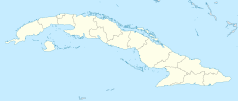Santiago de Cuba
| |||
 Katedra w Santiago de Cuba | |||
| |||
| Państwo | |||
| Prowincja | Santiago de Cuba | ||
| Powierzchnia | 1023,8 km² | ||
| Wysokość | 82 m n.p.m. | ||
| Populacja (2004) • liczba ludności • gęstość | 494 337 461,3 os./km² | ||
| Nr kierunkowy | 22 | ||
| Kod pocztowy | 90100 | ||
| Strona internetowa | |||
Santiago de Cuba – miasto i port w południowo-wschodniej Kubie, drugie co do wielkości w kraju, położone nad zatoką Morza Karaibskiego.
Jest stolicą administracyjną prowincji Santiago de Cuba. Siedziba rzymskokatolickiej archidiecezji.
Santiago de Cuba założone zostało przez hiszpańskiego konkwistadora Diego Velázquez de Cuéllara 28 czerwca 1514 roku. W latach 1522-1589 Santiago była stolicą hiszpańskiej kolonii Kuba. W 1898 o miasto toczyły się walki podczas wojny amerykańsko-hiszpańskiej, a przed miastem rozegrała się bitwa morska pod Santiago de Cuba.
Santiago de Cuba to główny ośrodek gospodarczy i kulturalno-naukowy wschodniej części Kuby. W mieście znajduje się uniwersytet.
Gospodarka
Przemysł:
- tytoniowy
- cukrowniczy
- włokienniczy
- drzewny
Ośrodek górniczy - rudy żelaza i manganu.
Ważny port morski.
Transport
Zabytki
Zabytki z okresu kolonialnego, na południowych przedmieściach twierdza Castillo de San Pedro de la Roca, wpisana na listę światowego dziedzictwa UNESCO.
Miasta partnerskie
 Cartagena, Kolumbia
Cartagena, Kolumbia Esmeraldas, Ekwador
Esmeraldas, Ekwador Estación Central, Chile
Estación Central, Chile Lizbona, Portugalia
Lizbona, Portugalia Maracaibo, Wenezuela
Maracaibo, Wenezuela Maracay, Wenezuela
Maracay, Wenezuela Montego Bay, Jamajka
Montego Bay, Jamajka Nocoya, Kostaryka
Nocoya, Kostaryka Oakland, Stany Zjednoczone
Oakland, Stany Zjednoczone Querétaro, Meksyk
Querétaro, Meksyk Rosario, Argentyna
Rosario, Argentyna Sabaneta, Wenezuela
Sabaneta, Wenezuela Santiago, Meksyk
Santiago, Meksyk Santiago de Compostela, Hiszpania
Santiago de Compostela, Hiszpania Santiago de los Caballeros, Dominikana
Santiago de los Caballeros, Dominikana Teror, Hiszpania
Teror, Hiszpania Palermo, Włochy
Palermo, Włochy
Media użyte na tej stronie
Made by author of Xramp, first uploaded by Denelson83 as Flag of Ecuador.svg, modifications by Husunqu.
Łatwo można dodać ramkę naokoło tej grafiki
Flag of Portugal, created by Columbano Bordalo Pinheiro (1857-1929), officially adopted by Portuguese government in June 30th 1911 (in use since about November 1910). Color shades matching the RGB values officially reccomended here. (PMS values should be used for direct ink or textile; CMYK for 4-color offset printing on paper; this is an image for screen display, RGB should be used.)
Flag of Jamaica. “The sunshine, the land is green, and the people are strong and bold” is the symbolism of the colours of the flag. GOLD represents the natural wealth and beauty of sunlight; GREEN represents hope and agricultural resources; BLACK represents the strength and creativity of the people. The original symbolism, however, was "Hardships there are, but the land is green, and the sun shineth", where BLACK represented the hardships being faced.
The flag of Navassa Island is simply the United States flag. It does not have a "local" flag or "unofficial" flag; it is an uninhabited island. The version with a profile view was based on Flags of the World and as a fictional design has no status warranting a place on any Wiki. It was made up by a random person with no connection to the island, it has never flown on the island, and it has never received any sort of recognition or validation by any authority. The person quoted on that page has no authority to bestow a flag, "unofficial" or otherwise, on the island.
Autor: Pedro A. Gracia Fajardo, escudo de Manual de Imagen Institucional de la Administración General del Estado, Licencja: CC0
Flaga Hiszpanii
The flag of the Dominican Republic has a centered white cross that extends to the edges. This emblem is similar to the flag design and shows a bible, a cross of gold and 6 Dominican flags. There are branches of olive and palm around the shield and above on the ribbon is the motto "Dios,Patria!, Libertad" ("God, Country, Freedom") and to amiable freedom. The blue is said to stand for liberty, red for the fire and blood of the independence struggle and the white cross symbolized that God has not forgotten his people. "Republica Dominicana". The Dominican flag was designed by Juan Pablo Duarte, father of the national Independence of Dominican Republic. The first dominican flag was sewn by a young lady named Concepción Bona, who lived across the street of El Baluarte, monument where the patriots gathered to fight for the independence, the night of February 27th, 1844. Concepción Bona was helped by her first cousin María de Jesús Pina.
Autor: nl:Gebruiker:Marc_G Marc G, Licencja: CC BY-SA 2.0 be
La cathédrale métropolitaine de Santiago de Cuba.
Autor: LukaszKatlewa, Licencja: CC BY-SA 3.0
Grobowiec rodziny Bacardi w Santiago de Cuba




















